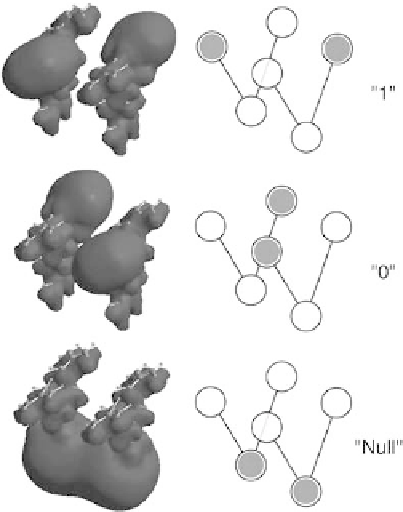Information Technology Reference
In-Depth Information
coupling acts to stabilize the molecule in a particular polarization and ensure that
once the cell is polarized it will require an outside influence to force a change [33].
This second level of nonlinearity is not present in the other implementations. Lent
et al. also point out that the kink energy in a molecular cell can be reasonably
approximated with simple electrostatic calculations. For the molecular system
described here, the kink energy was calculated to be 646meV.
In order to enable the molecular QCA cells to be clocked, a third stable state is
required. The molecular geometry described above was extended to include an
additional allyl group and permits the molecule to have a third stable state [32]. In
this molecule, alkyl bridges in a ''V'' shaped molecule connect 3-allyl groups (the
dots). This ''V'' shape permits the use of a vertically aligned electric field to induce
a potential difference between the upper sites (the two ends of the V) and the lower
site (the vertex of the V). This potential difference can be used to clock the cell—
when the potential of the lower dot is lower than the potential of the upper dots,
the cell will go into the NULL state. The group is considered a molecular cation,
with two neutral allyl groups and one positive allyl group. In this case it is the
positive charge that is transferred between the different dots. The molecule in the
three stable configurations is shown in Figure 4.37.
Figure
4.37.
Three stable configurations of ''V''-shaped QCA molecule [32]. Iso-
potential surfaces are shown on the left hand side and a schematic representa-
tion of the cell on the right. Reprinted with permission from [32]. (r 2003 IEEE)







Search WWH ::

Custom Search